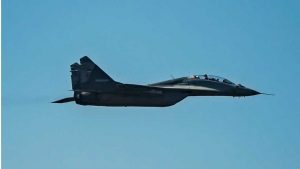
Russian regular forces are likely present in Libya, AFRICOM’s intelligence director said
Two Russian fighter jets have crashed in Libya since being deployed to country’s civil war on the side of Gen. Khalifa Hifter earlier this year, a senior US military official said today.
The US Africa Command believes more than a dozen Russian aircraft, first reported to have been deployed to Libya in May, are being flown by Wagner paramilitary pilots.
It is not clear whether the two MiG-29s were shot down, suffered mechanical failure or crashed because of pilot error, Rear Adm. Heidi Berg, director of intelligence for US Africa Command, told reporters by phone today. The first MiG crashed June 28, the other on Monday.
A video circulated on social media earlier this week in which a Russian-speaking pilot appeared to have landed in the desert with a parachute before being rescued by a Hind helicopter, which was painted in camouflage resembling that used by the Libyan National Army.
In the video, the pilot said he was no more than 70 kilometers (43 miles) from an airfield but did not specify which one. Berg said today that at least 14 Russian fighter jets are based out of Libya’s Jufra and Khdim air bases.
In May, the US military released aerial imagery showing MiG-29 and Su-24 aircraft on the ground in Libya, raising concern that the Kremlin was trying to “tip the scales” on behalf of Hifter in his fight against the UN-backed government in Tripoli.
AFRICOM said at the time that the fighter jets had been flown from Russia to Syria, where they were repainted before continuing on to Libya.
“These fighters are engaging in combat activity. We have seen them conduct ground strikes,” Berg told reporters. “They are not there for training the Libyan National Army.”
“We also know that they are not that good,” she said, referring to the two crashes.
Russia’s government denies it has military forces in Libya. Berg countered that narrative, saying AFRICOM assesses that it is likely that Russian military regulars are in the country, given how the Kremlin has deployed Wagner in other conflicts.
Some 338 Russian cargo flights arrived in Libya from Syria between November 2019 and the end of July, Berg said, citing the same number found in a United Nations report reported on by Reuters last week.
Last autumn, the US military assessed that Wagner only had “a handful of operatives” in Libya, Berg said. “Russian IL-76 aircraft travel from Syria into Libya regularly,” AFRICOM spokesman Col. Christopher Karns told Al-Monitor in July.
That number is now believed to be 3,000 Wagner fighters, as well as some 2,000 Syrian mercenaries fighting on Hifter’s side. The US military also assesses that Turkey has brought some 5,000 Syrian fighters to fight on behalf of the UN-backed government in Tripoli, and that Ankara has fielded several hundred regular forces.
For now, the cease-fire called for last week by Tripoli-based Prime Minister Fayez al-Serraj and Tobruk-based parliament Speaker Aguileh Saleh appears to be holding, despite the Libyan National Army’s vocal rejection, Berg said.
She said it is not clear whether that is out of respect for ongoing diplomatic efforts, or a need for both sides to resupply.
The State Department is exploring options with other nations for a demilitarization of the strategic coastal city of Sirte and the potential establishment of joint security cooperation as trust-building measures between the rival Libyan governments. The United States has repeatedly called on foreign militaries to leave the conflict.
AFRICOM commander Gen. Stephen Townsend warned in January that Turkey’s increased military support for Libya’s Tripoli-based government risked drawing in further Russian support for Hifter.
If Russia gains control of Libya’s oilfields via Wagner and introduces long-range air defenses to Libya, it could undermine potential for a future a solution to the war and pose a security threat to NATO’s southern flank, US officials have said.
Berg said AFRICOM does not assess that Russia has deployed long-range air defense systems such as the S-300 or S-400 to Libya. But she acknowledged that the mobile Russian SA-22 Pantsir defense system shot down an Italian drone and at least one US Reaper drone last year.
That has raised concerns among US military officials that Wagner personnel may misidentify aircraft in the multinational conflict. The United Arab Emirates, Egypt, France and other countries have reportedly conducted airstrikes on Libyan territory during the war.
Berg said that although suspected Wagner forces appear to be capable of deconflicting airspace along the Sirte-Jufra line, they have also declared no-fly zones in international airspace near Libya, leading to concerns that Russia’s irregular forces are pushing to expand their geographic control “well beyond their legal remit,” Berg said.
Earlier this week, two nuclear-capable US B-52 long-range bombers flew alongside Moroccan and Tunisian fighter jets in show-of-force missions over the southeast Mediterranean.
AFRICOM spokesman Col. Christopher Karns said the joint bomber exercise was not specifically directed at Russia’s presence in Libya. Statements by the command said the exercise was to show the US commitment to its partners in Africa.
“If Russia and China notice, that’s not a bad thing,” Karns told Al-Monitor via email.
